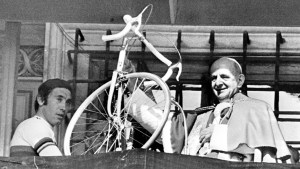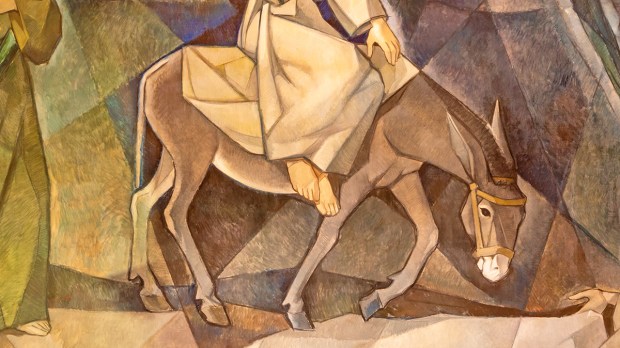In his Jesus of Nazareth, published in 2007, Pope Benedict XVI surprised many readers by pointing out that the Gospel of Luke doesn’t mention the presence of a donkey or an ox at Jesus’ birth in Bethlehem. The addition of the two animals is in fact an a posteriori construction derived from an excerpt from Isaiah, the prophet who had announced the arrival of a Messiah: “The ox knows its owner, and the donkey its master’s crib; but Israel does not know, my people do not understand …” (Is. 1:3).
While the presence of a donkey at the side of the infant Christ is therefore limited to folk tradition, this is not the only time we see the animal accompanying Christ. It is this animal that transported the Virgin Mary to Bethlehem before his birth, then to Egypt during the flight from the wrath of Herod. Above all — and this time, referenced in Scripture — it is this long-eared animal that Christ chose in order to make his “royal” entrance into Jerusalem right before his Passion.
From Christ to his Vicars
The donkey, an animal associated with Christ, is therefore logically associated with the papacy as well, but its presence is discreet and ambivalent. This could be explained by the original opposition between the Eastern and Western Churches from the 4th century onwards. Indeed, the patriarch of Constantinople did not ride a horse but, out of humility, followed the example of Christ and rode a donkey. In contrast, it would seem that the papacy favored the horse, a more “noble” and faster mount.
Nevertheless, the symbolism associated with the donkey has long been tied to the popes, as evidenced by the medieval festival of Cornomannia, a kind of carnival celebrated in Rome on the first Saturday after Easter. On this occasion, in the presence of the Roman population, the pope attended burlesque scenes during which an archpriest rode a donkey, but facing backwards. This was a particularly humiliating posture, because it was the opposite of Christ’s, and it played a cathartic role typical of this kind of event. A few years later, the antipope Gregory VIII, arrested by the legitimate pope Calixtus II in 1121, was forced, as a humiliation, to ride backwards on a horse with big ears.
As far as we know, few popes have ridden a donkey. One of the only pontiffs to have done so was Celestine V, a hermit monk who was also known as the only bishop of Rome to have renounced his office before Benedict XVI. The chronicle of the time attests that when he entered the city of L’Aquila about 60 miles east of Rome, in 1294, where he went to be crowned, the pontiff chose to pass through the gates of the city of Abruzzo on a donkey, in a gesture imitating the entry of Jesus into Jerusalem.
The donkey, an insult against the pope
The Renaissance put an end to the symbolic use of the donkey by the popes, the animal being more and more associated, as in the classical pagan culture that was rediscovered at the time, with stupidity. A specific event shows this evolution.
In 1495, the Tiber flooded. On the bed of the river, the stunned Romans found the corpse of a strange monster with a hybrid shape, the true form of which is still unknown today. The news made the tour of the city, of Latium, and of all the peninsula. Some clever printers of the Eternal City took advantage of the craze to sell lithographs representing the beast, letting their imagination run wild, and had certain success. Contemporaries became even more frightened and saw in the appearance of this monster in the city of St. Peter the sign of an apocalyptic decadence of the papacy.
In 1498, two merchants from Bohemia, Germany, stumbled upon one of these engravings, and immediately associated the strange monster—which had the head of a donkey—with the corruption of the pope. The image was brought back to Germany and copied by printers, spreading the image of “Papst-Esel,” the donkey-pope, to mock the Throne of Peter.
The story does not end there. In 1523, Martin Luther himself, in association with Philippus Melanchton and the engraver Lucas Cranach, took up the tool of propaganda and published a pamphlet in which he made an exegesis of this sinister monster haunting Rome. The donkey’s head, he said, is the sign of the idiocy of the Roman Curia; each part of other animals—elephant, raptor, ox—being similarly associated with a defect of the Holy See. It was a low-key attack, but one that succeeded, as the donkey-pope became, like a werewolf or a vampire, a famous monster in the Protestant tradition.
Since then, the donkey has generally disappeared from the “menagerie” of the papacy. We’ll just mention, in conclusion, that Pope Francis, in 2015, admitted to some choristers that he “sings like a donkey!”


